New partnership announced with Borderless
Sona and Borderless announce an exciting partnership.
Building a staff schedule couldn’t be easier.
Reduce payroll errors with real-time T&A.
Fill 50% more shifts with your own employees.
Ensure shifts are covered even if you're understaffed.
Manage absence requests and approvals.
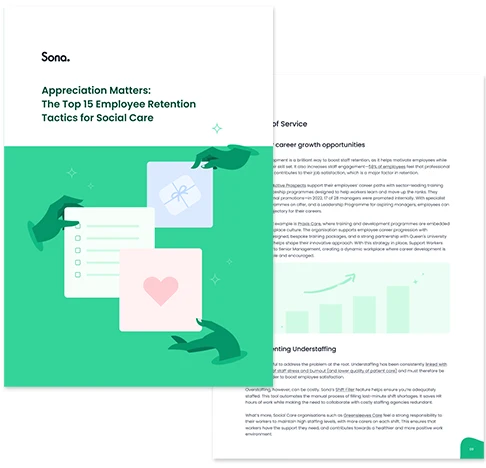
Practical ways to boost team morale with proven examples from across the sector.
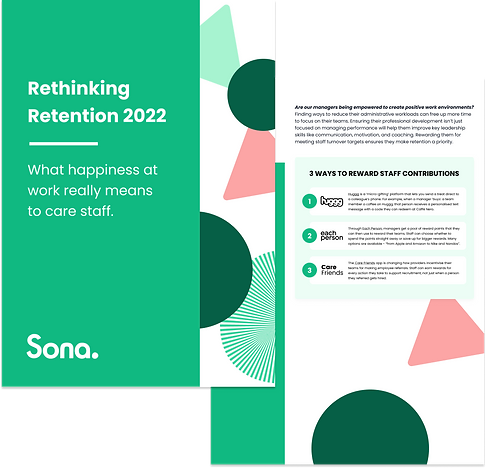
Find out what care employees say matters to them most at work.
Search and view employees with customised permission levels.
Key employment information all in one place.
Store visas, professional certifications and more with easy access.
Control personal and operational details of your staff.
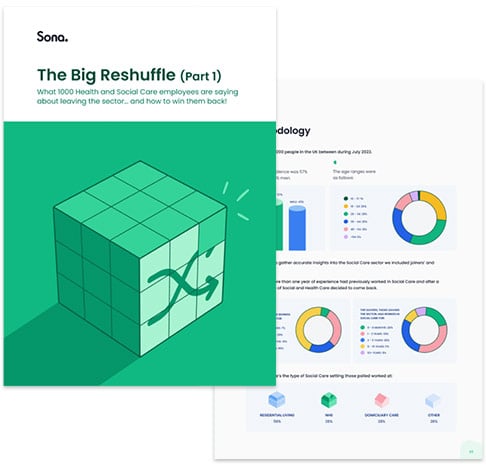
Why are people leaving Social Care, and where are they going?
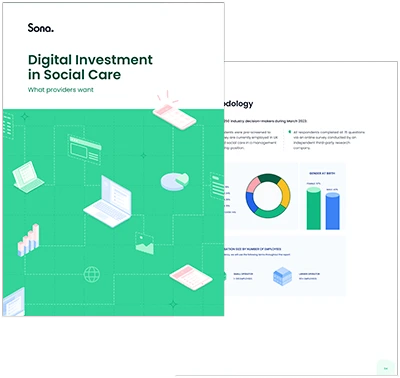
We asked 250 Social Care leaders about their attitudes towards digitisation and their plans for the next 12 months...
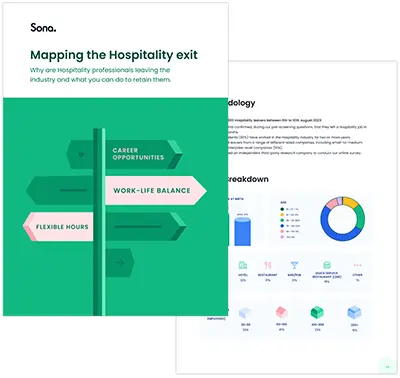
Why are Hospitality workers leaving the industry, and what can you do to retain them?
Share updates with a single click.

Staff can see relevant messages in one place.
Request post-shift feedback from staff.
Recognise staff contributions by sending them praise.
Identify staff at risk of churning.
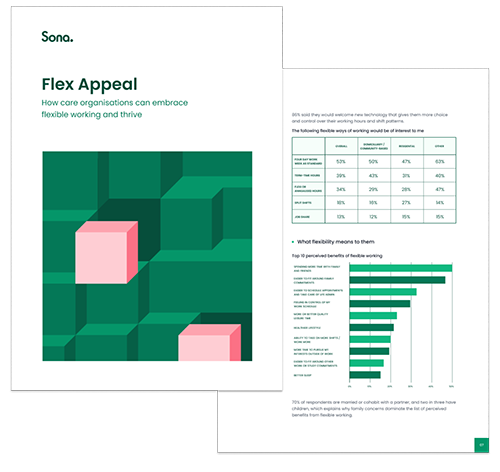
How care organisations can embrace flexible working and thrive.
Maintain quality of care and reduce costs.
Maximise profitability through AI-powered forecasting & scheduling.
Elevate your operational efficiency and guest satisfaction.
Streamline operations across sites.
Developed alongside Social Care experts with decades of combined experience.
See why we are the leading user-friendly, end-to-end platform that prioritises both efficiency and wellbeing.
The Sona Partner Network is an ecosystem of solution experts and complementary technologies.
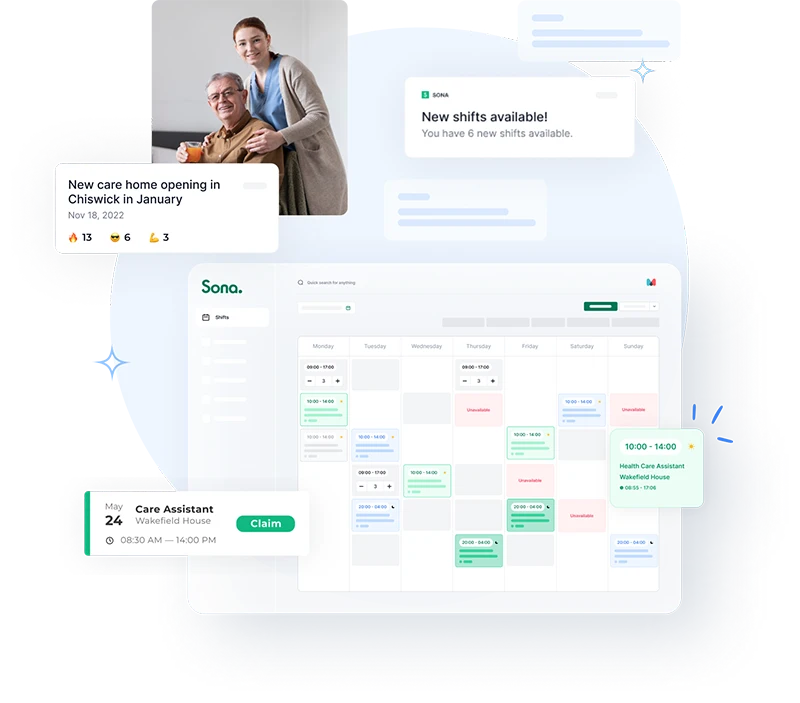
Give staff greater visibility of shifts available to work, with a simple "shift claim" process to increase their income.
Improve employee engagement and retention with a seamless employee communication platform.
Happier staff provide greater customer experiences, which in turn drives return rates, revenues and recommendations.
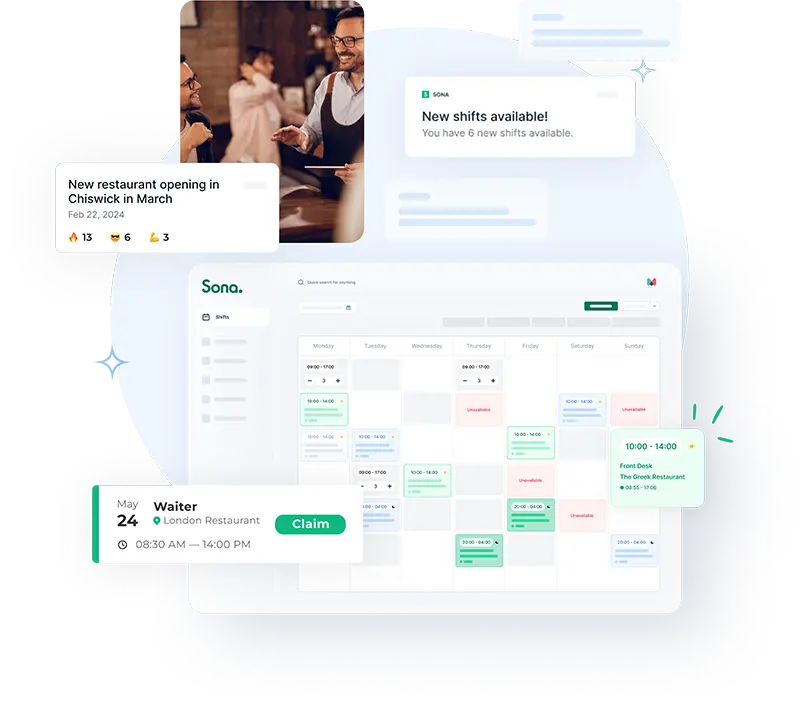
Give staff greater visibility of shifts available to work, with a simple "shift claim" process to increase their income.
Improve employee engagement and retention with a seamless employee communication platform.
Happier staff provide greater customer experiences, which in turn drives return rates, revenues and recommendations.
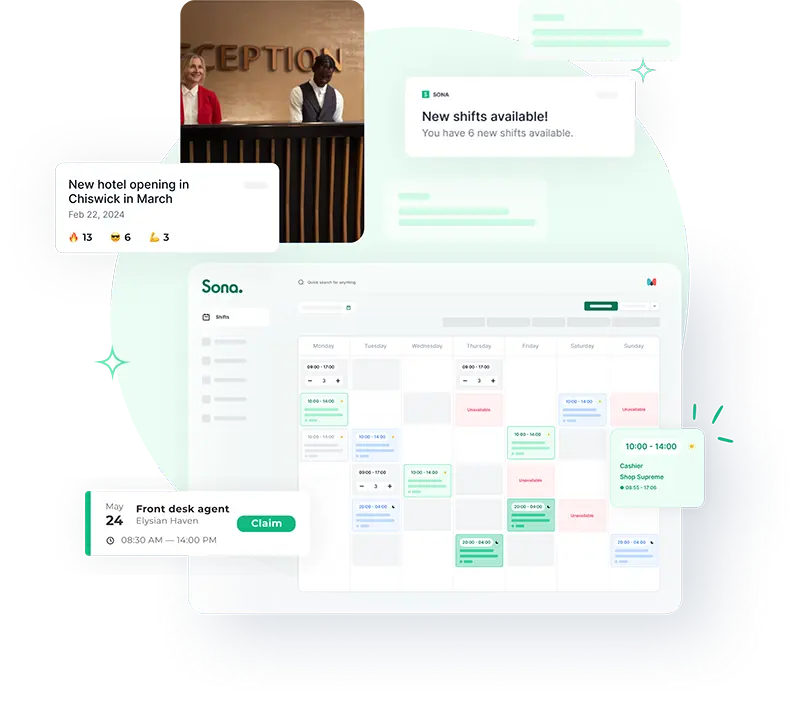
Meet the Sona team online with our webinar series or in-person at an event near you.
New research, insights, and strategies for frontline leaders.
Downloadable templates, reports and guides from Sona.
Stay up to date with the latest Sona news and research.
Learn how our customers are transforming their people operations.
| 3 min read
Sona and Borderless announce an exciting partnership.
| 2 min read
Sona and Found by Lottie announce an exciting partnership.
| 4 min read
Remove operational errors, drive efficiency, and help your team spend less time on admin with a unified solution.
PUBLISHED: February 2025
Download the report to learn how hospitality operators are embracing AI challenges and opportunities in 2025.
PUBLISHED: January 2025
Reveal the most important metrics in 2025!
PUBLISHED: December 2024
This infosheet is packed with practical insights to drive high-quality, low-regret WFM purchases.Everything you need to know about how next-generation solutions offer an alternative to legacy tools
7 minute read
Large organisations with a majority of their staff in deskless roles have developed in complexity over the last decade. From Social Care to Hospitality, Retail, and more, they’ve been working with digital tools to better deploy their workforce, weathering varied market challenges.
However, these tools - also known as legacy systems - are being replaced by next-generation solutions as their outdated structure and one-size-fits-all approach start becoming an obstacle for companies to thrive.
Top-down architecture refers to the rigid structure of older software. This type of build is non-customisable and expected to suit companies across different sectors, organisational structures, and operational complexities. Organisations will have to adapt their processes to the top-down architecture and invest in add-on solutions or workarounds as needed.
One example is a scheduling tool that doesn’t share data with the HR system, leading to teams in both departments having to work in silos.
Bottom-up architecture is characteristic of next-generation, flexible software which is made up of smaller building blocks. This allows an organisation to configure a tailored solution around its way of working, growth goals, and team structure.
In practice this means organisations are able to implement complementary “building blocks” that communicate seamlessly - for example, Scheduling and HR - therefore increasing operational efficiency.
The initial architecture of legacy systems prioritises broad, industry-agnostic features over deep, sector-specific functionalities. It meant imposing generic features that pushed teams to retrofit the solution into their specific use cases.
Example: Social Care providers require qualifications or skills of frontline staff to be visible in schedules. If generic software doesn’t include this feature, complex care settings need to create duplicate schedules or resort to spreadsheets. This negates the efficiency benefits of a scheduling software.
Impact on organisation: Teams are forced to build manual workarounds, increasing their workload while reducing the effectiveness of the software. These workarounds also lead to more data reconciliation activities to keep other records up-to-date and an increased risk of errors.
With a bottom-up architecture and deep sector-specific knowledge, modern solutions are configured to accommodate complex scheduling protocols, mandatory staffing criteria, payroll rules, and more. This targeted approach means organisations are supported to customise their functionalities and analytics, leading to easier implementation and faster ROI.
Read more: ROI comparison of Social Care digital solutions
The aforementioned lack of flexibility of top-down architecture leads to also having to retrofit company structures without any room for complex hierarchies with multiple sites. So, frontline organisations investing in a legacy tool can find their solution struggling to support the demands of multi-layered payroll needs and other requirements.
Example: Hospitality operators face challenges in managing locations with unique needs, leading to inefficiencies and potential compliance issues. I.e. A hotel where one location has a restaurant and another one doesn’t, would have difficulty scheduling staff with specific skills when using a top-down solution without manual intervention.
Impact on organisation: Teams in different locations may face varying challenges that the software cannot adequately address, leading to inconsistent operations and revenue loss.
A solution that is built to support complex hierarchies means that each location can specify its needs from the start and the intelligent scheduling feature would account for these requirements. Whether that’s team size, geographic location, visa requirements or preferred shift patterns, all these factors are taken into consideration and each site is supported by a next-generation solution.
Since legacy solutions are often out-of-the-box, functionalities aren't always configurable. This makes it difficult for organisations to specify their preferred growth metrics and ways of reporting. Leadership teams can experience friction and delays when looking for a specific insight, and it can take several teams and rounds of insights to produce a wellbeing survey or a gender pay gap report.
Example: When scheduling and payroll solutions don't communicate, teams have to manually reconcile invoices and payslips, then build expense reports based on the data. This can take a person anywhere from one day to one full week depending on the size of the organisation. As this is a monthly (or bi-monthly) activity, this single report ends up taking much of the capacity of an admin role on a regular basis.
Impact on organisation: Keeping analytics and reporting generic can obscure metrics that are essential to growth. Leaders are encumbered when they have to formulate plans or create forecasts, as they don't have easy access to the context necessary to keep them agile.
A bottom-up architecture would allow organisations to define their growth goals, share these with the appropriate staff, and set accountability and a strategy to achieve them. Because configurable building blocks communicate seamlessly, a next-generation solution pulls reporting data from every level of the organisation and presents it in accessible dashboards. This means every team can find the right insight, any time they might need it.
“At one point it would take me an entire day to do the invoicing, but having a custom-built invoicing report, that’s now reduced to two hours.”
Matthew Hacking
Purchase and Sales Order Coordinator
One significant drawback of legacy software is its limited ability to integrate with other sector-specific tools. In industries like Social Care and Hospitality, this limitation poses difficult operational challenges, as these vendors are essential for daily operations.
Example: Legacy providers often require organisations to purchase all their tools from a single vendor. This approach is not only expensive but lacks robustness, as well. In some cases, even when these tools are offered by the same provider, there is no easy way for them to exchange information as they were not built from the beginning to work together, but rather acquired as separate solutions.
Impact on organisation: The lack of integration pushes teams to resort to double data entry and manual reconciliation. This increases the administrative burden and the risk of errors, while impacting overall productivity and accuracy.
Bottom-up architecture has fully open APIs. Coupled with the aforementioned sector knowledge, this means next-generation solutions usually integrate with key vendors or are open to building such integrations in partnership with clients.
Watch now: What makes a Care system integration possible?
Overall, modern solutions adopt a bottom-up architecture, integrating seamlessly with other systems and offering deep configurability tailored to specific sectors. To sum up, this approach is ideal for growth:
Built with advanced programming languages like Elixir, these solutions can scale rapidly and adapt to the specific needs of each sector. For instance, Social Care providers can integrate scheduling with care planning tools, ensuring all data flows smoothly across systems.
AI-driven insights help organisations make informed decisions, from shift allocations to resource deployment, ultimately driving revenue. For example, better scheduling can reduce reliance on agency staff and overtime, improving staff deployment and reducing burnout.
Next-generation solutions offer robust integrations with sector-specific tools like eMAR for Social Care or POS systems for Hospitality, eliminating the need for double data entry and reducing the risk of errors.
Continuously evolving with new data sources and industry trends, these solutions keep organisations ahead of the curve, enabling proactive management and sustained competitive advantage.
If you’re ready to transform your WFM processes, it could be the best time to explore how next-generation solutions can help your organisation thrive. Book a quick consultation here.
If you liked this article, why not subscribe to our newsletter to get the latest news and views delivered straight to your inbox?
9 min read
This essential guide explains the evolution of WFM and why AI-driven technologies will influence the way organisations are run in the long-term.
10 min read
Learn when it's time to move on from pen & paper, a legacy system, or a non-Care specific software.
7 min read
Learn more about the three digital systems at the core of Care operations.